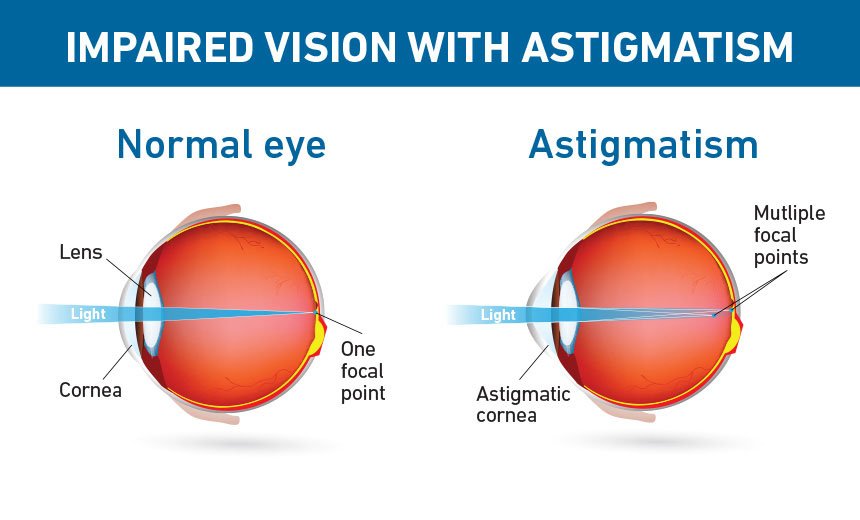Cataract Surgery and Astigmatism
There are various methods to address astigmatism during cataract surgery. Our skilled eye surgeons are prepared to help our patients reduce or eliminate astigmatism effectively.
What is Astigmatism
Astigmatism is a condition that hinders the eye’s ability to focus light consistently in all directions. This common condition occurs when the lens or eye is curved unevenly. This makes the eye shape more like a football than a baseball.
Astigmatism can impact both near and distance vision, often resulting in mild blurriness or double vision. Our doctors can assess the degree of astigmatism affecting your vision during your cataract evaluation.
Can Cataract Surgery Correct Astigmatism?
If you have astigmatism, it can now be effectively corrected during your advanced laser cataract procedure. We might use a laser during cataract surgery. This can help reshape the cornea. It can also treat your astigmatism, depending on how severe it is.
Laser incisions offer greater precision compared to traditional manual techniques. Fixing your astigmatism can improve your vision and may lessen your need for glasses or contact lenses.

Surgical Approaches to Address Astigmatism During Cataract Surgery
Cataract removal and astigmatism correction techniques vary for each patient. However, these procedures are usually simple. They can sometimes eliminate the need for glasses.
Cataract surgery is an outpatient procedure. It usually takes less than 20 minutes. If astigmatism needs to be corrected, it may take a few extra minutes. You will spend about two hours at the surgery center and then can rest at home for the rest of the day.
After cataract surgery with astigmatism correction, recovery is quick. However, patients should wait about a week before going back to their normal activities. A follow-up appointment a few weeks post-surgery is necessary to assess the new eyeglass prescription, if needed.
There are three effective ways to reduce or eliminate astigmatism during cataract surgery. These methods help patients see clearly. As a result, they may not need glasses or contact lenses
Limbal Relaxing Incisions
During cataract surgery, our board-certified cataract specialists can perform limbal relaxing incisions to correct moderate levels of astigmatism. We utilize advanced computer programs to achieve precise corrections for smaller amounts of astigmatism. Eye doctors will make small cuts in the cornea to reduce or eliminate astigmatism during the procedure. While limbal relaxing incisions are effective, they may not be sufficient for patients with more significant degrees of astigmatism.
TORIC® Intraocular Implant
For patients with significant astigmatism, a TORIC® Intraocular Lens can effectively reduce this condition. The toric lens is widely regarded as one of the best options for cataract surgery in astigmatic patients. This high-quality implant corrects astigmatism in the lens.
This is different from limbal relaxing incisions, which fix it at the cornea. Patients usually pay extra for this implant, but we find they are often very happy with the results. To ease the financial burden, we also offer zero percent financing options our team can discuss further with you.
LASIK
Following cataract surgery, our skilled eye surgeons can perform LASIK to effectively reduce or eliminate astigmatism. In some cases, a limbal relaxing incision or a TORIC® implant may leave a small amount of residual astigmatism.
We typically address this residual astigmatism with laser vision correction or LASIK. Patients can be assured that a small amount of astigmatism can be corrected. There is a safe and effective method for complete correction. A patient can start with a standard lens and later use LASIK to reduce astigmatism if they want to improve their vision.
We pride ourselves on offering the highest quality LASIK, specifically iLASIK, which is a bladeless, custom LASIK procedure. Our LASIK system uses a custom map of each patient’s vision to achieve the best results.
Does insurance cover cataract surgery for patients with astigmatism?
Insurance pays the same for cataract surgery, whether it uses a laser or not. Laser surgery is usually costlier and is often suggested for patients with astigmatism needing a high-quality lens implant. You must pay the extra costs for laser cataract surgery to fix astigmatism that are not covered by insurance.
Insurance might not cover all intraocular lenses (IOLs), so check your coverage before choosing to correct astigmatism. Insurance does not cover procedures specific to advanced lenses, which surgeons do not perform for standard monofocal lenses.
Can Astigmatism Develop After Cataract Surgery?
Most patients experience an increase in refractive astigmatism following cataract surgery. In fact, performing cataract surgery alone often exacerbates the astigmatic condition in many individuals. The use of large incisions and sutures can lead to undesirable alterations in the natural shape of the cornea.
Consequently, traditional large incision cataract surgery typically worsens corneal astigmatism, highlighting the benefits of sutureless, small incision techniques. Standard intraocular lens implants do not correct astigmatism like eyeglasses. This is because the lenses are placed inside the eye. They do not change the shape of the cornea.
Can Astigmatism Be Corrected After Cataract Surgery?
Astigmatism can be improved with a procedure called astigmatic keratotomy. This procedure involves making small cuts on the outer layer of the cornea. Interestingly, this technique tends to be more effective in older patients.
The incisions must be strategically placed to correct the undesirable oblong shape of the cornea. The length, depth, and location of these incisions play a crucial role in determining their overall impact.
Unlike cataract incisions, astigmatic keratotomy incisions are only partial thickness. Specialized, high-quality surgical blades made from diamonds are utilized for this procedure. Astigmatic keratotomy can be done at the same time as cataract surgery. This is beneficial because it doesn’t harm the eye or lengthen the surgery or recovery time.
If you need cataract surgery with astigmatism correction, contact SightMD. You can make an appointment to talk about your options with our doctors.

Can You Have Cataract Surgery Twice? Understanding Secondary Cataracts and YAG Laser Treatment
When Vision Becomes Cloudy Again Cataract surgery is one of the most common and successful procedures in modern medicine,…

“Blurry Vision” After Surgery?
What Happened to That “Blurry Vision” After Surgery? Long-Term Outcomes Explained Eye surgery—whether it’s cataract surgery or LASIK eye…

Evolution of Cataract Surgery
The Evolution of Cataract Surgery: How Technology Transformed Vision Care Cataract surgery has come a long way since the…